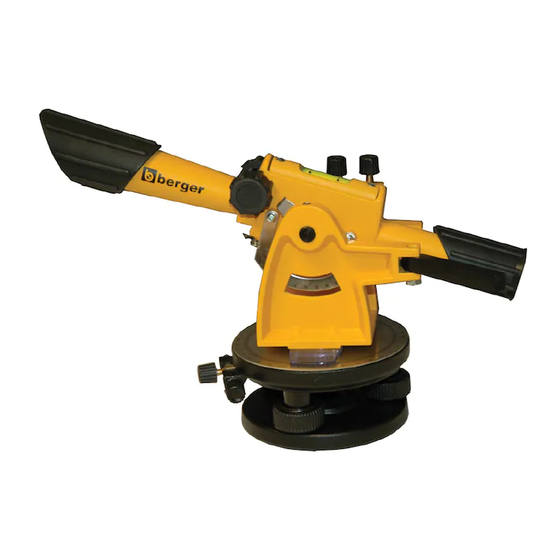
Summary of Contents for berger instrument Level and Transit-Level
- Page 1 INSTRUCTION MANUAL Level and Transit-Level Prepared and edited by HERMAN J. SHEA Former Associate Professor of Surveying, Massachusetts Institute of Technology FOR CUSTOMER SERVICE, PARTS & REPAIR CALL 815-432-9200...
-
Page 2: Table Of Contents
Your instrument is precision made and capable of numerous applications. Listed in the table of contents are a few representative building, engineering and farming This quality Berger instrument has been inspected twice for accuracy before leaving problems. the factory. The instrument has also been given the best protection possible against damage during transportation. -
Page 3: Setting Up The Instrument On The Tripod
1. SETTING UP THE INSTRUMENT ON THE TRIPOD Your Berger Instrument should now be leveled up, but to be certain, double-check. Rotate the instrument 180° so the vial is reversed. If the bubble will not center when Your instrument is packed in a carrying case of modern design which affords reversed, follow adjustment procedure outlined under "Bubble Adjustments."... -
Page 4: Preparing Telescope For Use
5. PREPARING TELESCOPE FOR USE Inches and Eighths to Decimals of a Foot The telescope magnifies the image many times, so the field of view is limited. Therefore, line up the telescope to your target by sighting along the telescope barrel much as you would aim a rifle. -
Page 5: To Measure A Difference In Elevation Requiring More Than One Set-Up
Suppose one of your points is below the line of sight and the other above (Fig. 6B), C 7. MEASURING AND LAYING OUT HORIZONTAL ANGLES is 4 feet 6-1/2 inches below the line of sight, and point D, the underside of a floor 7.1 Setting Up Over a Point With Plumb Bob beam is 7 feet 9-3/8 inches above the line of sight (the latter reading having been To measure or lay out an angle, set the instrument over a point and level it up. -
Page 6: Reading The Vernier
This is what your vernier looks like after having turned the angle (Fig. 12). Now, let's read the angle. Remember, we have turned to the left, so we are going to use the side of the vernier between the vernier index "V" and the letter "L". NOTE: Do not be confused that the positions of "L"... -
Page 7: Special Uses Of Transit-Level Instruments
9. SPECIAL USES OF TRANSIT-LEVEL INSTRUMENTS In the following three sections, two special operations are illustrated which can be performed with instruments of the transit-level type but cannot be performed with a dumpy level. When leveling lock is engaged, it converts the transit-level to a level, so all other functions described in this manual can be performed. -
Page 8: Practical Applications
11. PRACTICAL APPLICATIONS Offset Grade Stakes for a 12 foot Driveway 11.1. Grade Line for a Sewer CUT 2' Steps to find the slope necessary for a household sewer connection are shown below (Fig. 17). Notice that the invert or flow-line of the pipe is used in each instance. The 90°... -
Page 9: Care Of Instrument
13. CARE OF INSTRUMENT 14. WARRANTY It will pay dividends to treat your instrument well. CST/berger (Seller) warrants the equipment of its manufacture to be free of defects in workmanship and material for a period of one year from date of purchase. If Avoid possibility of accident. -
Page 10: Adjustment Points
15. ADJUSTMENT POINTS 18 • Berger Instruments Berger Instruments • 19... - Page 11 255 W. Fleming Street Watseka IL 60970 USA a division of The Stanley Works (815) 432-9200 Z94-TRANSLEV (1018)

Need help?
Do you have a question about the Level and Transit-Level and is the answer not in the manual?
Questions and answers